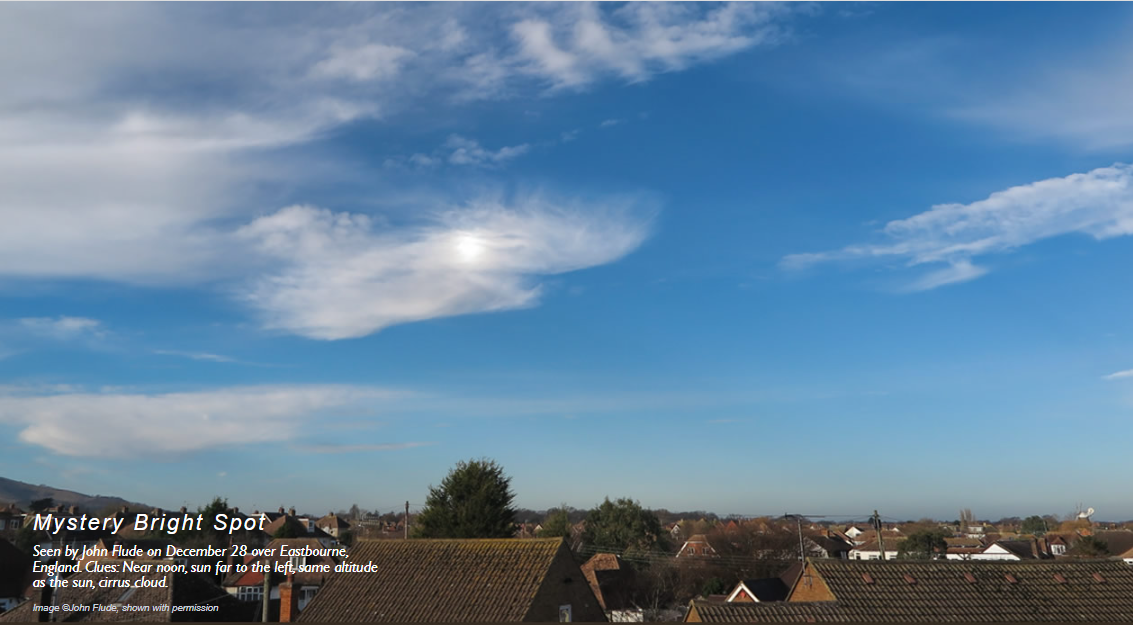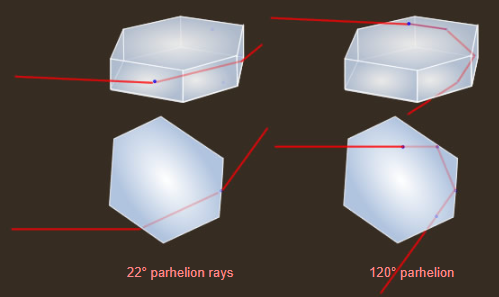Mystery White Spot
Mystery White Spot: Exploring an Atmospheric Phenomenon
Atmospheric optics never ceases to amaze us with its mysterious and captivating displays. One such phenomenon, known as the "Mystery White Spot," has intrigued sky watchers for years. These isolated bright spots, far from the sun, can be quite perplexing to identify. However, by carefully observing the surrounding conditions and analyzing the available data, we can begin to unravel the secrets behind these enigmatic occurrences.
The Clues That Unveiled the Mystery
On December 28th, John Flude spotted a peculiar bright spot over Eastbourne, England. What made this sighting intriguing were the specific clues associated with it. The spot appeared near noon when the sun was far to the left, and it shared the same altitude as the sun. Additionally, a cirrus cloud was present in the vicinity. These details provided valuable hints in deciphering the nature of this celestial anomaly.
To determine the exact position of the spot, John Flude meticulously measured its coordinates using a combination of tools. Since a magnetic compass near metal and the window proved unreliable, an Ordnance Survey map and Google Earth came to the rescue. The spot's azimuth, roughly estimated between 295-300° (WNW), was derived from these measurements. By cross-referencing this data with the time of capture, which was accurately recorded at 11:56 UTC, the azimuth of the sun (178.9°, almost due south) was obtained. Combining these values allowed for the calculation of the spot's azimuth from the sun, ranging from 116-121°.
Unveiling the Mystery: An Ice Halo Emerges
With these calculations in hand, the mystery was finally solved – the bright spot was an ice halo. More specifically, it was an exceptionally radiant 120° parhelion. Parhelia are white atmospheric optical phenomena often referred to as "sun dogs" due to their proximity to the sun. However, 120° parhelia can be elusive and challenging to observe. In this case, the brightness of the spot stood out, adding to its uniqueness. Another intriguing aspect was the absence of a parhelic circle passing through it, further distinguishing it from typical sightings.
The Role of Observation and Documentation
This fascinating discovery highlights the importance of keen observation and meticulous documentation when encountering unusual atmospheric events. When witnessing something out of the ordinary, it is crucial to note the precise position, date, and time, along with the relevant time zone and whether daylight saving time is in effect. Additionally, maintaining an accurate camera clock set to a known time zone is essential for recording sky phenomena reliably.
To enhance the accuracy of observations, it is recommended to capture several handheld camera images rather than relying solely on video footage. This helps eliminate potential misidentification caused by lens reflections. While videos may provide dynamic visuals, they often fall short in providing accurate directional information. Still shots, on the other hand, offer a more detailed view, enabling a thorough analysis of the phenomenon.
The Intricacies of Ice Crystals and Cirrus Clouds
To understand the formation of the Mystery White Spot, we must delve into the intricate world of ice crystals and cirrus clouds. Hexagonal plate aspect ice crystals within the cirrus cloud played a crucial role in creating this captivating optical display. The complex path of light rays passing through these crystals gives rise to a variety of atmospheric phenomena. It is worth noting that while diagrams often depict perfectly regular crystals, such uniformity is rarely observed in nature.
In conclusion, the Mystery White Spot serves as a reminder of the awe-inspiring wonders that unfold in our atmosphere. By carefully examining the surrounding conditions, analyzing available data, and embracing keen observation, we can uncover the secrets behind these enigmatic atmospheric optics phenomena. So, next time you encounter something extraordinary in the sky, make sure to document your observations accurately and let the mysteries of the atmosphere reveal themselves.

Mystery Bright Spot
Seen by John Flude on December 28 over Eastbourne, England. Clues: Near noon, sun far to the left, same altitude as the sun, cirrus cloud.
Image ©John Flude, shown with permission
Isolated bright spots far from the sun can be hard to identify. The cirrus patch and altitude the same as the sun were important clues.
Using the photograph and the camera position John Flude carefully measured its spot's position. A magnetic compass near metal and the window was unreliable so this was supplemented by an Ordnance Survey map and Google Earth. The spot's azimuth was 295-300° (roughly WNW)
The image was taken at 11:56 UTC (always have an accurate camera clock for sky phenomena!) giving a sun azimuth of 178.9° (almost due south).
Combining these gives the spot's azimuth from the sun of 116-121°.
Mystery solved - An ice halo. An exceptionally bright 120° parhelion.
120° parhelia are white and often hard to see. This one was unusually bright. Another unusual feature was the lack of a parhelic circle passing through it.

When you see something unusual note your position, date and time - plus time zone and whether daylight saving time. Keep the camera clock accurate to a known time zone.
Note the position relative to the sun.
If possible take several hand held camera images. This helps eliminate misidentification of lens reflections.
Video is not much use for getting directions and still shots are better. Zooming video in and out and waving the camera about is even worse!
Hexagonal plate aspect ice crystals in the cirrus cloud made it. The complex ray path is best achieved when the crystals are thick or have alternate sides long and short. We see perfectly regular crystals in diagrams but they are rarely so in nature.
Note: this article has been automatically converted from the old site and may not appear as intended. You can find the original article here.
Reference Atmospheric Optics
If you use any of the definitions, information, or data presented on Atmospheric Optics, please copy the link or reference below to properly credit us as the reference source. Thank you!
-
<a href="https://atoptics.co.uk/blog/mystery-white-spot/">Mystery White Spot </a>
-
"Mystery White Spot ". Atmospheric Optics. Accessed on November 26, 2024. https://atoptics.co.uk/blog/mystery-white-spot/.
-
"Mystery White Spot ". Atmospheric Optics, https://atoptics.co.uk/blog/mystery-white-spot/. Accessed 26 November, 2024
-
Mystery White Spot . Atmospheric Optics. Retrieved from https://atoptics.co.uk/blog/mystery-white-spot/.